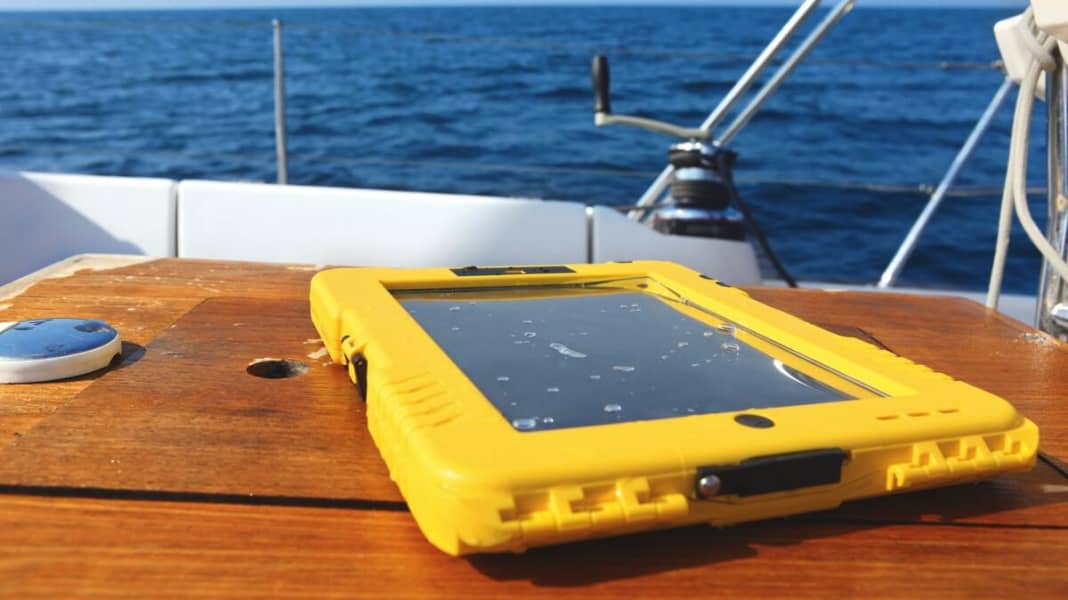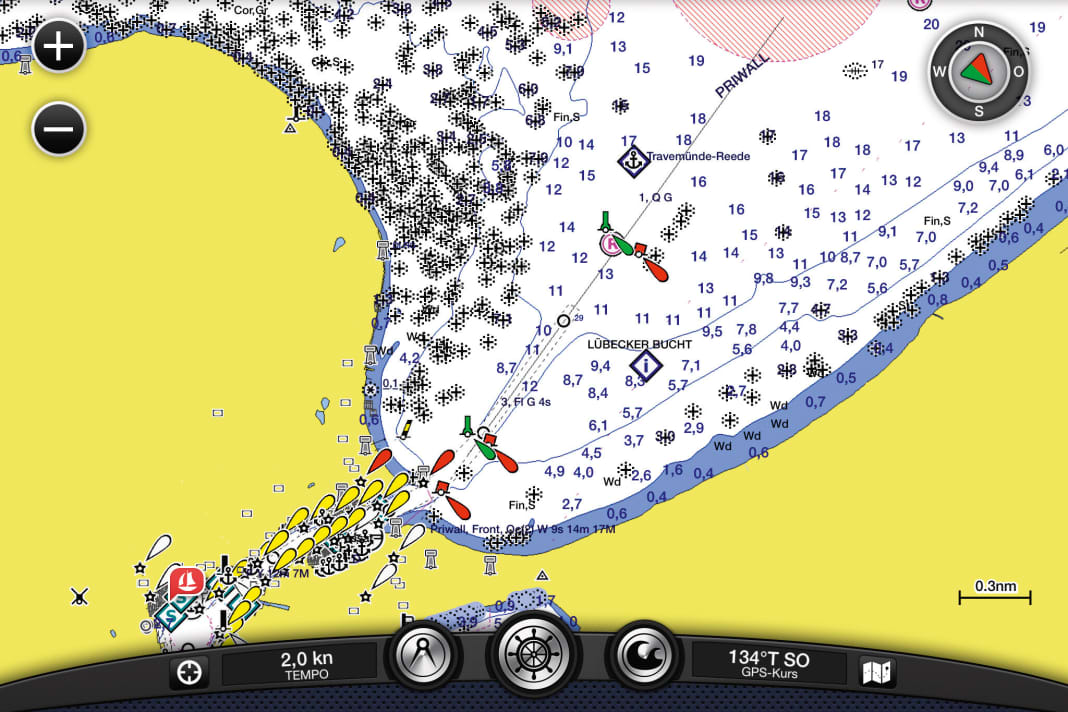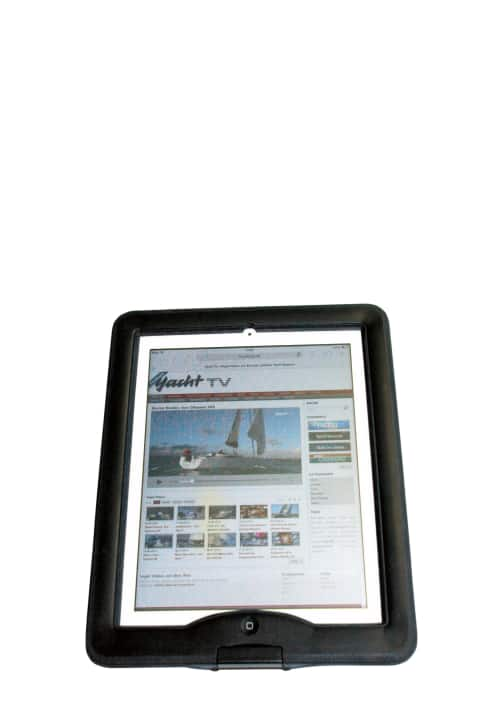
Tablets have long since proven themselves as a plotter supplement. The reasons for this are literally obvious: low weight, increasingly better battery life and high-resolution displays. Permanently mounted plotters no longer have much to compete with. Even if everything about them is designed for use at sea, they remain immobile and can hardly be used for any other purpose. Tablets, on the other hand, can be transformed into books, gaming devices or fully-fledged computers at the touch of a button.
But which one is best suited for use at the lake - and which apps turn the device into an aid?
The iPad - a true all-rounder
The fact that manufacturers have become ever more technically harmonised makes the choice even more difficult. Software therefore plays a decisive role in the search for the right model. After all, what good is great computing power if not a single chart can be loaded? Ultimately, only Apple's iPads with the iOS operating system or the Android system developed by Google and partners can be considered as a plotter replacement. Nautical chart apps and navigation aids can be downloaded from the respective Google and Apple app stores.

Apple's iPads probably enjoy the best reputation among sailors. The reason: a wide range of high-quality apps, timeless design and durability. But the days when the iPad was only available in one version are long gone. The iPad has now had many children - with variable storage capacities and extras. The names: "Pro", "Air" and "Mini". For sailors, the smallest model, the "Mini", is unlikely to be considered as a replacement for a plotter due to its screen size: The display is only five centimetres larger than that of an iPhone 6 Plus.
The Comparison of iPad Pro (33 cm display diagonal) and iPad Air (25 cm diagonal).
Our impression: The iPad Pro, which was released at the end of 2015, is indeed an imposing appearance with its dimensions - quite a lump when you hold it in your hand. At 713 grams without the case, it is a good one and a half times heavier than the iPad Air at 437 grams. Its size makes it bulky, and it might be too big for some control columns. The large display sometimes takes its toll - even when plugged into a 12 V socket, the battery level drops when the sat nav app is running. Find out what makes the iPad Pro a valuable companion at sea in our iPad Pro Special.
Android tablets: competition for Apple is growing
In addition to iPads with iOS and GPS (cellular), Android devices are also possible. In our app test In 2017, we compared the latest iPad (128 GB memory) with the Samsung Galaxy Tab S3 LTE and the Galaxy Tab A LTE. The apps run smoothly on all three tablets. There are clear differences, for example, in the readability of the displays. The prices range from 300 (Tab A) to around 600 euros (iPad/ Samsung Galaxy Tab S3).
But the choice is even greater. Countless manufacturers offer various sizes and features. Sony's Xperia Z4, for example, scores points for being waterproof (although only guaranteed by the manufacturer for fresh water). In general, it is difficult to make statements about the suitability of Android tablets as on-board devices due to the large number of available Android tablets, as the hardware requirements are too varied. However, in the models we have tested in the past, there was nothing to criticise about either the hardware or the software. The selection of apps was always more decisive.
Spoilt for choice - the search for the right app
In the last YACHT test, the iOS-based apps were still clearly ahead. The developers had usually created their programmes for the Apple versions first, so that they almost always had more features and were more stable. In the meantime, the lead of the iOS navigation apps has continued to shrink. The very good Android-based app from iSailor, for example, is brand new. Navionics has now also
many features in the Android version that were still reserved for iOS devices in the last test. Nevertheless, many app developers continue to design new features for Apple devices first, as they do not have to be tested on as many different tablets as with Android - the large selection of hardware remains the curse and blessing of the Google system. Stability problems are mostly reported by the lesser-known tablet manufacturers. Samsung, on the other hand, is considered the Apple equivalent of the Android world, with almost all apps being tested on it - making the brand a good choice in case of doubt






We put nine sat nav apps through their paces and found out: The lead for the "global market leader" (according to the manufacturer) Navionics is becoming ever thinner. Not only well-known (paper) map manufacturers are entering the market, but niche providers are also expanding the range with useful extras. Some apps, for example, correspond with the existing on-board electronics (e.g. Time Zero and iSailor), while others offer weather enhancements.
Some apps, such as Navionics, Plan2Nav and Garmin's Bluechart, also rely on information that users can integrate into the app themselves. This includes information about restaurants, services and local shopping facilities. Some of this information is very useful, even if it is not verified. The results from our app test.
What does the world cost? - A lot!
The prices make choosing the right app even more difficult. Often only the download of the programme is free, while some manufacturers charge prices for the nautical charts similar to those for plotter charts. Sometimes the areas are compact and therefore inexpensive (Seapilot, Germany: €25), while elsewhere entire seas are mapped (Garmin, Baltic Sea Complete: €130). In this case, the future requirements should be roughly calculated right at the start.

Accessories - waterproof covers

With the purchase of the tablet comes a new concern: What's the best way to protect the expensive item from water and salty sea air without restricting its functionality?
If you decide in favour of navigation with a tablet, the first thing you need to decide is whether waterproof charging is important to you - because this is possible with only a few protective cases.
And the ease of use of all buttons is not always maintained, depending on the product. If you already have a mount, you should first check whether the device still fits with a protective cover. We tested eleven covers and cases.
The test winners: The "Lifedge" and "Lifeproof Nüüd" cases (pictured) stood out particularly favourably. Both offer perfect protection and do not restrict the functionality of the device. However, they are only available for the iPad. The Lifedge comes with a practical handle, while the Lifeproof has a fold-out stand. Both models cost around 129 euros.
The bottom line: There is a solution for almost every budget, and waterproofness was not a problem with any model. The price-performance winners are undoubtedly the film cases, but they also have the greatest impact on the display. The hard cases, on the other hand, promise both impact and drop protection. To the full test report.

